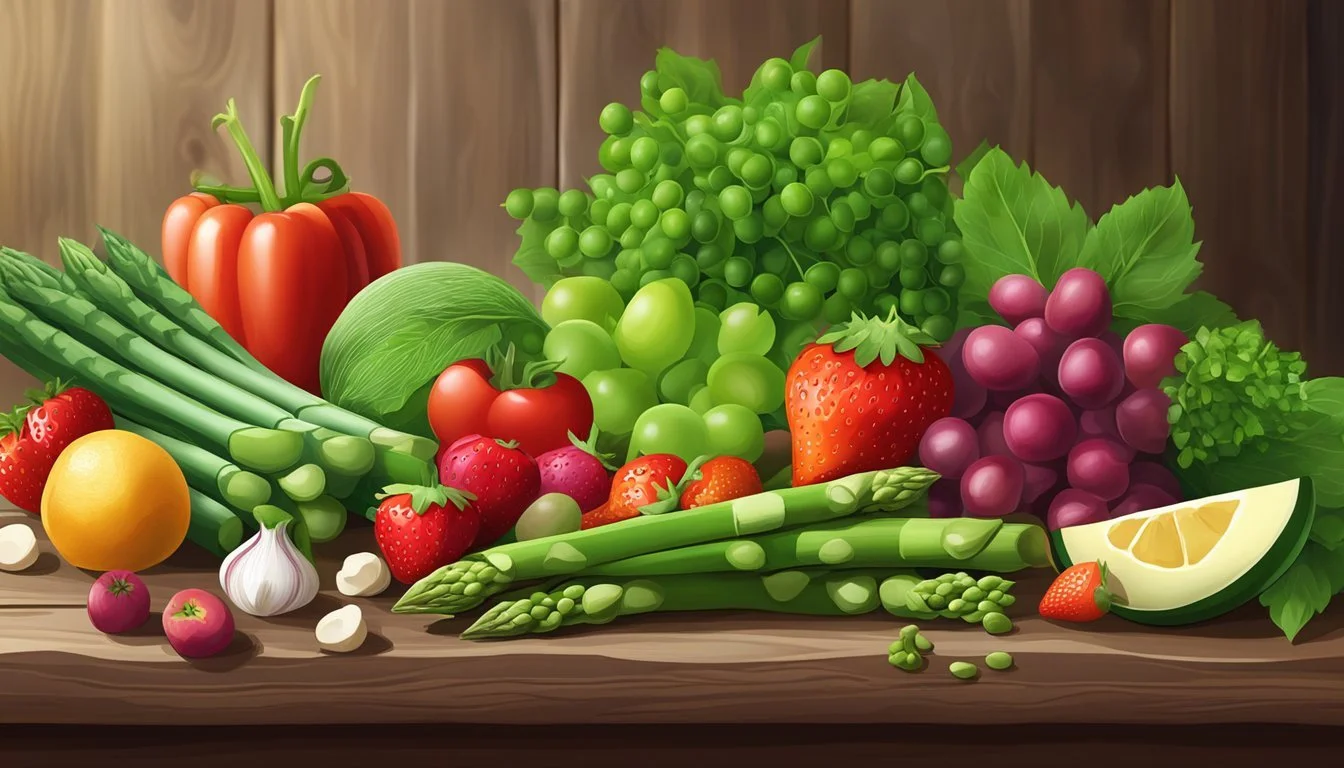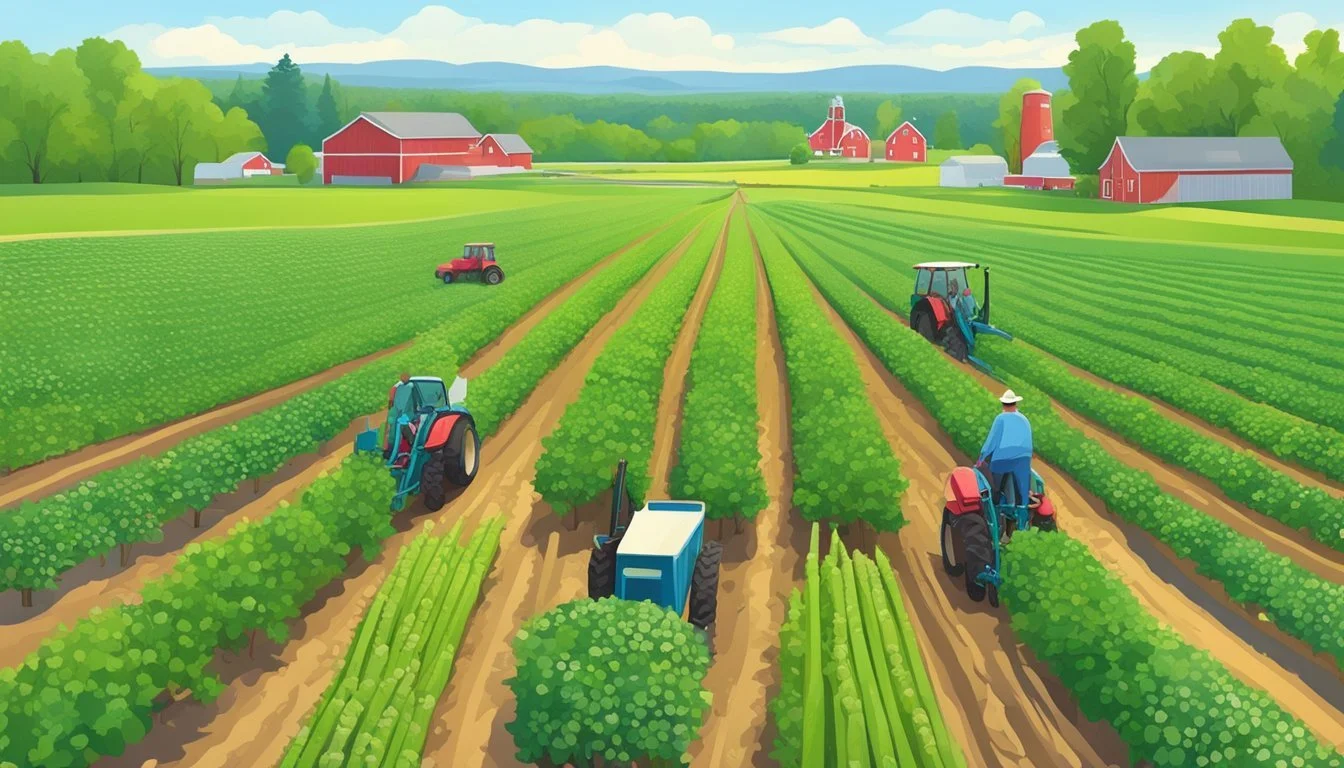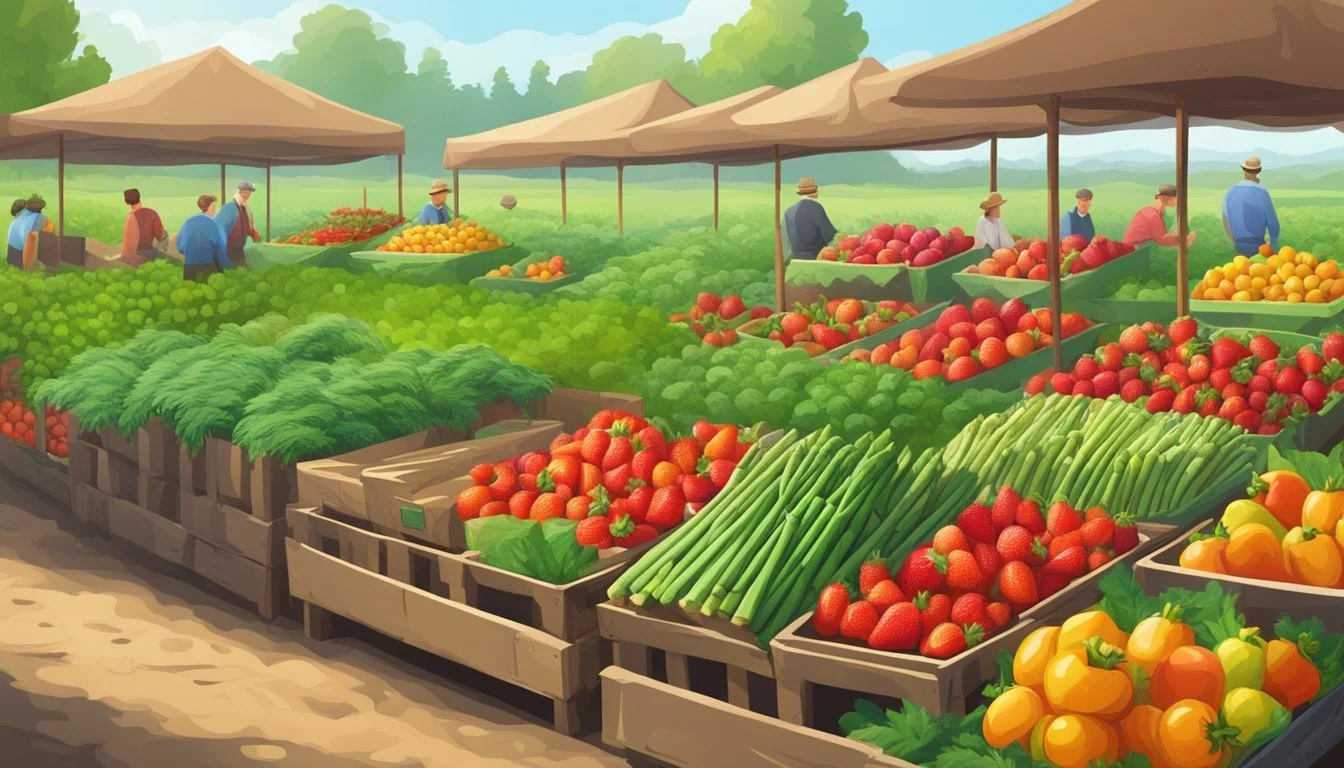Massachusetts Seasonal Fruit & Vegetables in April
Your Fresh Guide
This Article is Part of our Massachusetts Seasonal Fruit & Veg Calendar
As April arrives in Massachusetts, the landscape begins to awaken from its winter slumber, offering a variety of seasonal produce that marks the beginning of the local harvest period. This transition period is characterized by the gradual rise in temperature and longer days, which contribute to the growth of early spring vegetables and the availability of certain wild edibles unique to the region. April's produce includes a selection of hearty greens and root vegetables alongside foraged goods like fiddlehead ferns and nettles, which are among the first to emerge.
The state's agriculture at this time is robust and diverse, catering to the anticipation of fresh, local ingredients after the colder months. Farmers and gardeners prepare their soil for planting, while early crops such as arugula (how long does arugula last?), radishes, and peas begin to make their appearance in farmers' markets. Asparagus (What wine goes well with asparagus?), an early spring favorite, points its spears skyward, promising a taste of the season's freshness.
Consumers in Massachusetts look forward to April, not only for the progressing warmth and bloom but also for the chance to integrate locally-sourced produce into their diets. Supporting local agriculture during this month means participating in a sustainable food system and enjoying flavors at their peak. As each variety becomes available, it brings with it a reminder of the cycle of growth and renewal that is so integral to the agricultural calendar of the region.
Understanding Seasonal Produce
In April, Massachusetts transitions into spring, marking a shift in the state’s agricultural offerings. This month begins a new growing season, introducing a variety of cool-weather crops.
Benefits of Seasonal Eating
Seasonal eating supports local agriculture and ensures consumers enjoy the freshest produce. In April, Massachusetts' residents can find spring vegetables like asparagus (how long does asparagus last?) and lettuce. These crops are in their prime, offering peak flavor, nutrition, and often at a lower cost due to reduced transportation needs. Eating seasonally also means the produce is harvested at the right time, which translates into a higher content of antioxidants and vitamins for the consumer.
Key Benefits:
Fresher produce with optimal flavor
Higher nutritional value
Supports local farmers and economy
Environmental sustainability with less transportation
The Impact of Climate on Harvest
Massachusetts experiences a range of climates, which dictate the harvest times of various produce. The state’s month of April is characterized by its cool-weather, which is conducive to the growth of specific cool-weather crops. For instance, greens like spinach and arugula thrive in the mild temperatures before the onset of summer heat.
Spring Harvests Include:
Fiddleheads: Harvested in April and May
Spinach: Typically available in spring
Arugula: Known for its cool-weather tolerance
The unique climate of Massachusetts makes it possible for these vegetables to be available in the early spring months, making it an excellent time for consumers to purchase local, in-season produce.
April's Seasonal Fruits
April in Massachusetts is a transitional period where the cold of winter fades and early spring fruits begin to emerge. Consumers can expect limited fruit options due to the region's climate.
Early Spring Fruits
In April, rhubarb stands out as the primary fruit available in Massachusetts. Rhubarb, typically regarded as a vegetable, is often used in culinary applications similar to fruit. It's one of the first plants to become available and is known for its tart flavor, making it ideal for sweetened dishes like pies and compotes.
Rhubarb: Begins to appear in April, availability increases as the month progresses.
Strawberries might begin their season in late April, but this is highly dependent on the weather conditions during the preceding months. These fruits usually arrive closer to the end of spring, with availability peaking in subsequent months.
April's Seasonal Vegetables
April in Massachusetts is a month of transformation in the fields and gardens as frost gives way to growing warmth. In this time of renewal, certain vegetables reach their optimal freshness and are ready to be enjoyed for their flavor and nutritional value.
Green Vegetables and Legumes
Asparagus spearheads the arrival of green vegetables in April. This sought-after stalk is not only versatile in culinary use but also packed with nutrients. Adding to the green bounty, spinach and lettuce provide leafy options for salads and sides, both known for their tender leaves during cool spring growth. For legumes, peas (both green and snap varieties) start to flourish, offering sweetness and crunch to dishes.
Asparagus: Tender, nutritious, and versatile
Spinach & Lettuce: Fresh, tender, ideal for salads
Peas: Sweet, crunchy, perfect for fresh eating or light cooking
Root Vegetables
Root vegetables like onions and carrots enjoy the April soil, delivering flavors ranging from sweet to pungent, perfect for both raw and cooked dishes. Beets, with their earthy sweetness, are also a staple in April's harvest. They can be roasted, boiled, or served up in salads. Potatoes, including varieties that overwintered, start becoming available, with their comforting starchiness and ability to absorb a myriad of flavors.
Onions: Pungent and versatile
Carrots: Crunchy and sweet, great raw or cooked
Beets: Earthy and sweet, suitable for various preparations
Potatoes: Comforting, flavor-absorbing startActivity
Planning for Subsequent Months
As the last frost thaws and spring takes hold in Massachusetts, gardeners and farmers are preparing for the variety and abundance of produce that the coming months will bring.
Looking Ahead to May and June
In May, Massachusetts's fields and farms become vibrant with the greens of early summer. Expect to see an increase in the production of leafy vegetables like kale and cabbage, both known for their health benefits and versatility in the kitchen. Fava beans (how long do fava beans last?) and peas also make their appearance, providing fresh flavors and the promise of summer's arrival. As one progresses into June, these crops continue to thrive and reach peak availability.
May Produce:
Leafy Greens: Kale, Cabbage
Legumes: Peas, Fava Beans
June Produce:
Continuation of leafy greens and legumes
Expansion into a wider variety of beans
Summer Harvest Preview for July and August
With the summer heat in full swing by July, the focus shifts to some of the season's most anticipated offerings. Blueberries burst onto the scene, perfect for pies, jams, or simply eaten by the handful. Alongside them, fields begin to yield cauliflower (how long does cauliflower last?), adding to the diversity on the dinner plate. August is a time of abundance, with corn standing tall—a staple for any summer barbecue and a fixture in the New England culinary landscape.
July Harvest:
Fruits: Blueberries
Vegetables: Cauliflower
August Bounty:
Vegetables: Corn, continued cauliflower
The full spectrum of summer harvests at their peak
By planning for these upcoming months, one can make the most of the seasonal produce that Massachusetts has to offer.
Cultivation and Harvesting Practices
In Massachusetts, April marks the beginning of the growing season when farmers employ various cultivation methods to ensure a bountiful harvest. These practices are critical during the changing weather conditions as they manage frost and optimize rain levels, focusing on sustainability and organic methods to combat pests and promote healthy crop yields.
Sustainable Agriculture in Massachusetts
Farmers in Massachusetts incorporate sustainable agriculture techniques to enhance soil integrity and water conservation. Crop rotation is a common practice, preventing pest accumulations and managing plant diseases linked to monoculture. Cover crops, such as legumes, are planted post-harvest to protect the soil from erosion, maintain fertility, and regulate moisture levels, which is vital during the unpredictable rain levels of the early spring.
Massachusetts growers often implement integrated pest management (IPM) strategies which involve monitoring crops for pest activity and applying control methods only when necessary to reduce the use of chemicals. This approach, coupled with the fostering of beneficial insects, contributes to the ecological balance and preservation of local biodiversity.
Organic Farming Techniques
Organic farming is on the rise, with many Massachusetts farms obtaining organic certification. These farms avoid synthetic fertilizers and pesticides, instead relying on natural amendments like compost and manure to enrich the soil. Cultural controls, such as selecting pest-resistant varieties and using physical barriers like row covers, help protect crops from pests without chemical intervention.
Organic farmers pay close attention to the timing of planting to circumvent issues with frost and maximize the use of natural light and warmth as the season transitions from winter. Timing is also crucial for water management, as April showers can fluctuate greatly and the careful scheduling of irrigation can prevent both drought stress and waterlogging.
By employing these cultivation and harvesting practices, growers aim to ensure that crops such as fiddleheads and parsnips thrive in the early season and set the stage for a successful harvest throughout the year.
Consumer Guide to Buying Local
April in Massachusetts beckons the start of a fresh harvest season. Consumers keen on tapping into the state's seasonal offerings can find a variety of locally grown produce. This guide helps to identify where to find these offerings and emphasizes the importance of supporting local farming communities.
Where to Find Seasonal Produce
In April, seasonal produce becomes available in numerous locations throughout Massachusetts. Farmers' markets spring to life, offering fresh, locally-sourced fruits and vegetables. Another reliable source is community-supported agriculture programs (CSAs), where consumers can subscribe to receive regular shares of produce directly from the farms. Additionally, many local grocers and co-ops will stock seasonal items from nearby farms. To aid in locating these resources, the following list highlights where to look:
Farmers' Markets: Check municipal websites or local bulletin boards for schedules and locations.
CSAs: Search online for "CSA near me" or visit localharvest.org for a directory.
Local Grocers and Co-ops: Ask staff for information on locally sourced produce.
Supporting Local Farmers and Markets
Purchasing produce from local farmers and markets provides significant benefits to the community and the economy. It ensures that farmers receive fair compensation for their labor, keeps the local economy robust, and reduces the environmental impact associated with long-distance transportation of goods. When consumers choose local options, they not only obtain fresh, high-quality products but also help to sustain the state's agricultural heritage.
To support local farms and markets:
Prioritize Purchasing Local: Look for signs or labels that indicate local sourcing.
Engage with Farmers: Take the opportunity to ask questions about the produce and farming practices.
Promote Awareness: Share information about local markets and seasonal produce with friends and family.
Nutrition and Health Benefits
Eating a diet rich in seasonal produce from Massachusetts in April can offer enhanced nutrition and health benefits. Consumers enjoy a range of fresh vegetables and fruits that can boost immune systems and reduce inflammation.
The Nutritional Value of Seasonal Food
Seasonal produce in April typically includes a variety of vegetables and fruits that are at their peak in nutrition. Vegetables like asparagus and fiddleheads are high in vitamins A and C, which are essential for immune support and skin health. They also provide fiber that aids in digestion. The first spring nettles also appear and bring forth a wealth of minerals like iron and calcium. These early spring foods not only offer freshness but also rich, concentrated nutrients that our bodies crave after winter.
Key Nutrients:
Vitamin A: Essential for healthy eyes and skin.
Vitamin C: A powerful antioxidant that supports the immune system.
Fiber: Important for digestive health.
Iron: Critical for blood health and energy levels.
Calcium: Key for bone strength.
Cooking with Fresh, Seasonal Ingredients
When it comes to cooking, the benefits of using fresh, seasonal ingredients are manifold. They tend to be more flavorful, which can reduce the need for added salt or sugar in meals. Fresh, seasonal vegetables like rhubarb, commonly associated with April in Massachusetts, not only provide a tangy flavor to dishes but also boast dietary fiber, vitamin K, and calcium, contributing to bone health and digestion. The act of cooking fresh produce can also inspire healthier meal choices, steering home cooks toward creating balanced, nutrient-rich plates.
Cooking Benefits:
Flavor: Seasonal ingredients often have a superior taste.
Nutrition: Fresher produce means more retained nutrients.
Health-Conscious Choices: Cooking with fresh ingredients supports the making of healthier dishes.
Food Preservation and Storage
Food preservation and storage techniques vary widely, but focusing on proper methods can ensure the longevity and quality of Massachusetts' seasonal produce. These approaches are key to enjoying the local harvest long after its peak availability.
Extending the Shelf Life of Fresh Produce
Proper storage can significantly extend the shelf life of fresh produce. Refrigeration at the correct temperature is crucial for items like asparagus, which is harvested in April. Asparagus should be stored upright in a container with an inch of water at the bottom, or wrapped in a damp paper towel and placed in a perforated plastic bag in the crisper drawer. This can keep it fresh for up to four days.
For root vegetables such as parsnips, a cool, dark, and well-ventilated space is ideal. Parsnips can last up to two weeks when stored in this manner. It's also important to separate ethylene-producing fruits (like apples) from other produce to prevent premature ripening.
Canning and Freezing Techniques
Canning and freezing are effective ways to preserve the flavors of Massachusetts in April. Each technique has its specific requirements for safety and quality:
Canning: This method is ideal for high-acid foods, such as early spring fruits, and involves placing them in jars and sealing them in a water bath to create a vacuum. This process can preserve the food for up to a year. Foods must be canned according to safe, tested recipes to prevent the risk of foodborne illness.
Step Description 1 Sterilization of jars and lids to prevent contamination. 2 Packing the product tightly to minimize air space. 3 Processing in a water bath or pressure canner per safe guidelines.
Freezing: Most vegetables must be blanched before freezing to halt the activity of enzymes that cause spoilage. Blanching involves boiling the vegetables for a brief period and then plunging them into ice water to stop the cooking process.
Vegetable Blanching Time (minutes) Asparagus 2-4, depending on thickness Parsnips 2-3
Once blanched, they can be dried, placed in freezer-safe bags or containers, and stored at 0°F or below to maintain quality for several months.
These preservation methods allow residents to have access to local produce outside its growing season while maintaining nutritional content and taste.









